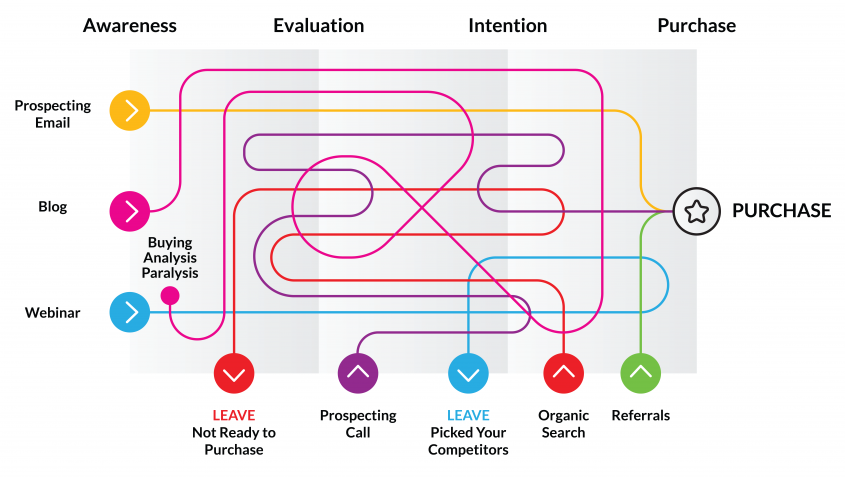For B2B tech marketers, trying to engage and excite prospects is hard – and that was before the pandemic hit and the digital competition seriously ramped up. So as your overwhelmed buyer is blasted with yet more content and ads, how do you get your brand on their radar, build trust and land sales? It may be time to re-look at how you use your marketing funnel.
Why the classic funnel doesn’t work in B2B
Since ad agency executive Elias St. Elmo Lewis developed the marketing funnel concept in 1898 (yup, that’s right, over 100 years ago …), marketers have been using this format in some form. Ok, it’s been honed and tweaked over the decades, but broadly the concept of breaking down the buyer’s journey into distinct stages still rings true.
Today’s tech marketers use some form of this funnel and will have customised it for their own business. You may have adopted:
- a straight-line approach from acquisition to growth
- a non-linear funnel such as Forrester’s maze or
- a more modern lifecycle or flywheel approach.
Whatever your approach, it’s clear that buyers move through stages, and it’s your job to pull on the levers. The only challenge is, that the stages today don’t look like they used to. With around 94% of B2B buying journeys starting online, leads can enter at any stage. Prospects no longer walk through predictable steps linearly. Buyers often want little or no influence from a vendor. Instead they favour independent research and reviews (and on that note, if you don’t already have one, here’s why you need a brand ambassador program).
The new marketing funnel
B2B marketers still have to attract, engage and convert leads – just not necessarily in that order. So, what’s right for your business? If your tactics are not delivering a high volume of leads, it may be time for you to reimagine your marketing funnel:
- Get clear on your customer journey – the traditional funnel is (broadly) an ideal representation of the journey, and you’ll no doubt have mapped out the journey pre-Covid. But 2020 has turned that on its head – we know that today’s journeys are even more messy, and buyers are in control. So, you need to understand how prospects really become customers – even if this means having several versions of a journey. Work with all customer-facing teams (internal and external) and create up-to-date journey maps. You’ll be surprised by what you find.
- Consider ‘funnel juggling’ – recognise that to drive real marketing effectiveness, you may need ‘funnel juggling’ (as introduced by Mark Ritson). Given that prospects don’t neatly fit into your funnel design at each stage, you may need to take an agile approach. Look carefully at your dashboard data and determine if you need to mix up the long-term and short-term activation tactics. You can read how others did this well in his blog post.
- Ensure you grow every stage of the funnel – the conical funnel concept suggests you throw the net wide at the top, then this reduces as leads qualify and narrow down to real prospects. As marketers, you may focus on one or two stages typically near the top, but to maximise lead generation and get deals over the line you need to look at the full funnel. It sounds obvious, but are you implementing growth strategies that target every stage?
- Ensure there is only one approach – while marketing and sales may be two separate entities – there is only one customer journey. Marketing has traditionally owned the top of the funnel, handing leads to sales. But fast-forward to 2020 and the lines are officially blurred. Both teams must collaborate throughout the buyers’ journey and provide a unified, single experience to customers. If the old approach doesn’t work for you, now’s the time to agree on a new concept with sales.
- The funnel doesn’t end with a purchase – for many tech companies, the dream is to land and expand. So as marketers, you’ve got to think beyond the bottom of the traditional funnel and consider a flywheel approach (a circular process where customers feed growth). How can you nurture customer relationships, how can customers feed into your product development, how can they become brand champions? This unending loop can yield opportunities far beyond the initial sale.
For many tech marketers, the funnel has been an effective method for lead generation. But in today’s market, you need to invest in creative strategies that keep your buyers engaged – particularly with long sales cycles. If the traditional funnel doesn’t work for your go-to-market team, revisit what you have and put in place a model that enables stronger orchestration and more importantly, better results in 2021.
(Image credit: Get Accept)





